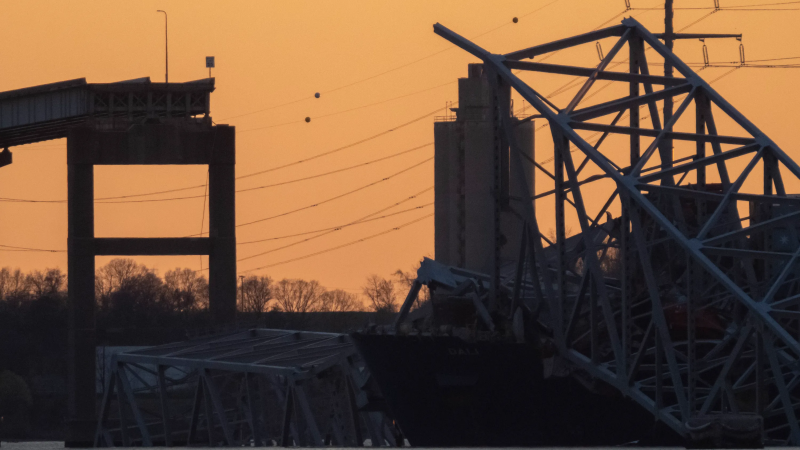Cargo ship audio recording reveals intense moments leading up to Baltimore bridge collapse
Details from the moments leading up to the devastating Francis Scott Key Bridge collapse were discovered in the cargo ship's "black box" voyage data recorder (VDR) as the pilot tried to alert authorities to the oncoming disaster.
The Dali, 984-foot Singapore-flagged vessel, reportedly lost power while transitioning out of Baltimore Harbor and struck the bridge at about 1:27 a.m. Tuesday, the National Transportation Safety Board said. The bridge, a nearly 2-mile critical artery in East Coast shipping, crashed into the Patapsco River within seconds.
Local, state, and federal officials established a Unified Command in response to the collapse. On Thursday, the command announced it had paused dive operations and vehicle recovery due to hazardous conditions in the river from the wreckage.
The 22-member crew of the Dali has remained on board since the crash, Coast Guard spokesperson Cynthia Oldham previously told USA TODAY. No one on the ship was injured. Eight construction workers were fixing potholes on the bridge when it collapsed. Two of them survived, and the others are presumed dead.
Some experts estimate the bridge will take two years to rebuild and cost at least $350 million, depending on the condition of the structure's foundation underwater. U.S. Transportation Secretary Pete Buttigieg said Thursday the first $60 million in federal funds for emergency work has been approved.

Minutes leading up to bridge collapse
On Tuesday, the Coast Guard recovered the audio and provided it to NTSB officials, investigator Marcel Muise said in a news conference Wednesday night. Roughly six hours of VDR data was provided to NTSB from midnight to 6 a.m. Tuesday, Muise said, and a group of experts will conduct an in-depth analysis of the audio.
The timeline provided by federal officials provides the most detailed account yet of the moments leading up to the disaster and will be the focus for investigators as they try to understand what caused the tragedy — and how it could be prevented:
- Muise said several alarms were heard on the recording just before 1:25 a.m., followed about a minute later by steering commands and rudder orders.
- At 1:26:39 a.m., the pilot on duty made a radio call for assistance to tug boats in the area, and 45 seconds later ordered the port anchor dropped.
- At 1:27:25 a.m., the pilot said on a radio call that Dali had lost power and was nearing the bridge. Around that same time, the officer on duty for the Maryland Transportation Authority told officers who were at both ends of the bridge for the road repairs to close traffic, which likely saved lives.
- At 1:29:33 a.m., as the powerless Dali was drifting at 8 mph, the VDR recorded "sounds consistent with the collision of the bridge," Muise said. Six seconds later, the pilot reported to the Coast Guard that the bridge was down.
NTSB Chair Jennifer Homendy noted the ship’s VDR is a basic system compared to an aircraft’s black box, providing only a "snapshot of the major systems on a vessel." She said the agency has long wanted more information to be recorded.
Contributing: Christopher Cann, Jorge Ortiz, USA TODAY
Disclaimer: The copyright of this article belongs to the original author. Reposting this article is solely for the purpose of information dissemination and does not constitute any investment advice. If there is any infringement, please contact us immediately. We will make corrections or deletions as necessary. Thank you.




